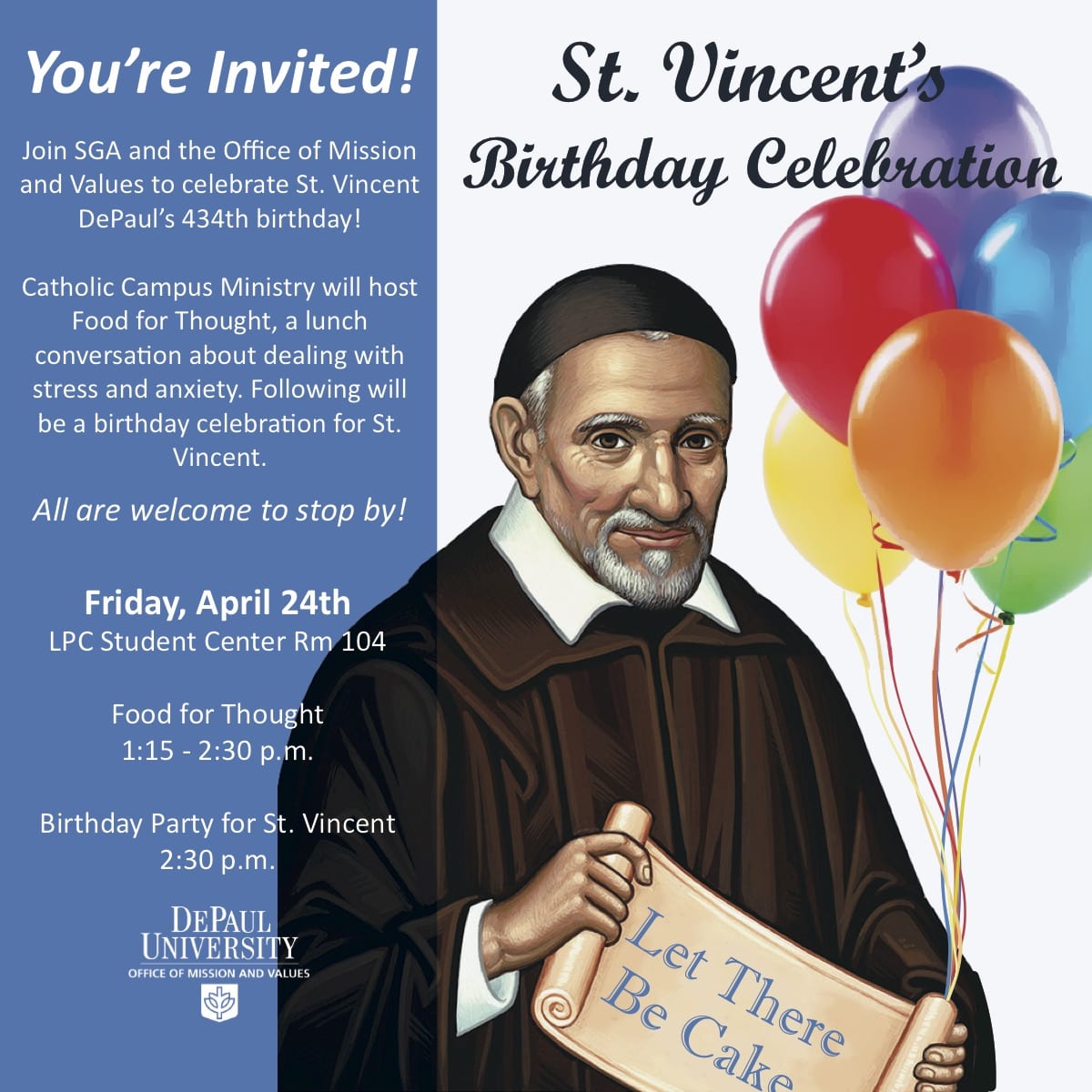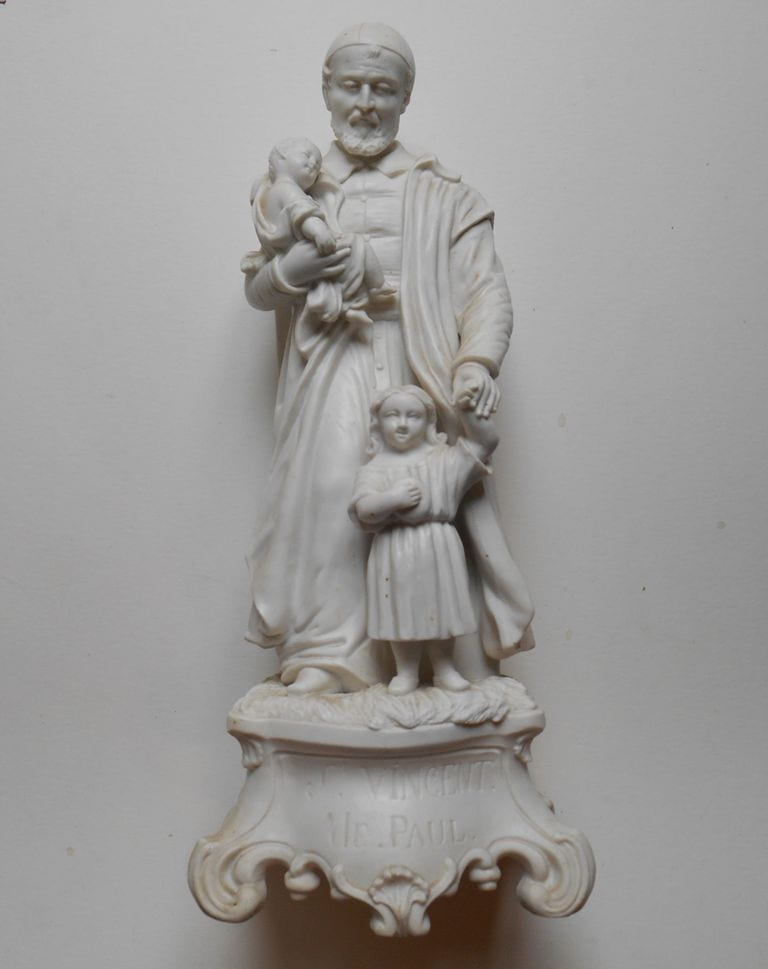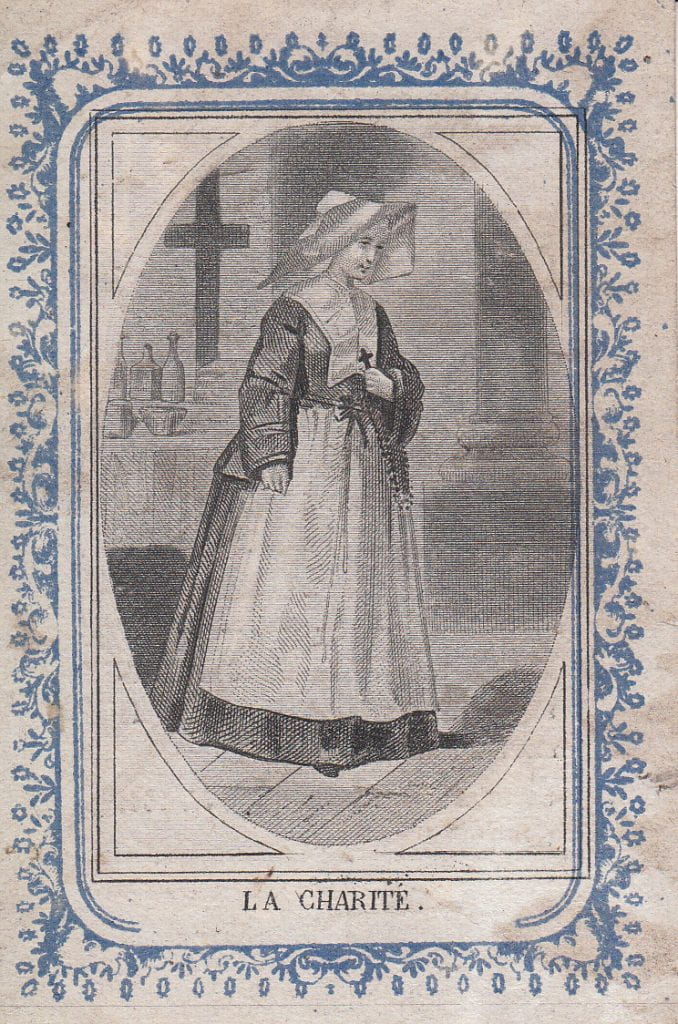The Vincentiana Collection in the Archives and Special Collections Department of DePaul University’s Richardson Library has recently purchased this early 19th century color lithograph of St. Vincent. The legend at the bottom reads: “St. Vincent de Paul. Founder of the priests of the Mission and of the Sisters of Charity, and of the Pitie, Bicetre, Salpetriere and Foundling hospitals. Born in 1576. Died in 1660. Dedicated to the Maternity Society.
Justice Killing?
by Katie Brick
I was inspired when I read about Denise and Bill Richard, parents of an 8-year boy killed in the Boston Marathon bombing, who asked Federal prosecutors to take the death penalty off the table. I was challenged – would I do the same if my kids were killed that way? Theoretically: yes. But I would never ever want to test that theory, nor am I in an omniscient position to judge how grief impacts people or what they think will bring them solace.*
So I am one of the growing number of people who want the death penalty to be taken out of the equation in the U.S. Don’t give it as an option to prosecutors, to bereaved loved ones, to the criminal justice system.
When the time from sentencing-to-death can be decades, there is a pragmatic reason for ending the death penalty. Each new appeal and delay brings the tragedy back up in the minds and hearts of survivors. In a Boston Globe piece titled, “To End the Anguish, Drop the Death Penalty,” the Richards wrote, “The defendant murdered our eight-year-old son, maimed our seven-year-old daughter and stole part of our soul. We know that the government has its reasons for seeking the death penalty, but the continued pursuit of that punishment could bring years of appeals and prolong reliving the most painful day of our lives.” They continued, “As long as the defendant is in the spotlight, we have no choice but to live a story told on his terms, not ours. The minute the defendant fades from our newspapers and TV screens is the minute we begin the process of rebuilding our lives and our family.”
In my opinion, religious principles are another reason to end the death penalty. My religious denomination, among many others, opposes the death penalty on religious and spiritual grounds. Thank you Catholic Church for offering some clear reasoning about themes of the dignity of the human person and protecting life vis a vis the death penalty, which can be seen in an April statement opposing the death penalty from the Massachusetts Catholic Bishops.
With DePaul University’s mission and geography, the issue of the death penalty is particularly relevant to those of us who attend and work here. DePaul is grounded in a Catholic tradition that opposes the death penalty. Our Vincentian character calls us to attend to the dignity inherent in each human person and particularly to serve those who are on the margins of society – people who disproportionately are sentenced to death. For example, while African Americans comprise about 14% of the U.S. population, they make up 42% of people currently awaiting execution.
Students who volunteer or do academic work throughout Chicago as part of our Urban mission tenet become aware of the disproportionate incarceration rates of people of color and many students are from communities where the justice system has often proved itself to be unjust and worth questioning. Our College of Law has been a leader around justice in capital cases, and I have been to some incredibly moving DePaul educational events on the topic.
In fact, anti-death penalty activist Sr. Helen Prejean felt such a kinship between her work and the DePaul mission that she donated her archives to the University, and each spring we now have Sr. Helen Prejean Week, which she anchors. During her most recent visit, the DePaulia reports that Sr. Helen said, “It boils down to this: That no human being can ever be identified completely with the worst act of their life…Life is fluid. There’s a transcendence in us. We can change.” This is another reason I do not believe in the death penalty – I have heard incredible stories about death row inmates that involve wisdom, repentance, faith, and human connection. What human can decide to end a life? Is that not up to God?
In a talk at DePaul, I heard Sr. Helen say that she believes most people who are in favor of the death penalty are simply undereducated. They don’t understand the lack of justice with much of the process around who gets sentenced to death, they mistakenly believe it will bring healing and resolution to victims’ loved ones and communities, and they are not aware of other just alternatives that will protect communities and hold people accountable for their actions.
It seems as if Massachusetts, whose last state execution was in 1947, may have gotten the education Sr. Helen is talking about. A recent Boston Globe poll showed that just 19 percent of Massachusetts residents wanted the Boston Marathon bomber to get the death penalty. So whose needs are being met with achieving the verdict of death? Why does killing someone to punish them for being a killer seem righteous to a majority of Americans – albeit a shrinking one as attitudes continue to change? What is the meaning in sentencing Dzhokhar Tsarnaev to death when those who might have opposed such a sentencing were excluded from the jury pool and the Federal government had to spend so much time and money not to prove him guilty – that was never in doubt – but to convince a jury to sentence him to death?
As a person of faith, I hope this high profile case continues to raise these sorts of questions. I hope it causes more of us – including me – to continue our education around capital punishment and what must be done. I hope for more healing now that the trial is over (is it over?) and will keep all those impacted by the Marathon bombing in my thoughts and prayers, for that is one thing I can do here and now.
*I suggest reading the novel “The Sweet Hereafter” by Russell Banks for some perspective on how the legal system can delay the healing of individuals and rip communities apart. This book still haunts me when I scan the news or hear about families like the Richards, and indeed, sometimes art or literature moves me more than religious dictates around ethical issues.
Katie Brick is the Director of the Office of Religious Diversity at DePaul University.
DRMA Winter Quarter Lecture 2015, The Gondi: Family Strategy And Survival In Early Modern France
This lecture was presented at DePaul University on March 11, 2015 in the Richardson Library.
Notwithstanding widespread French admiration for Italian culture in the sixteenth century, Italian influence at the heart of French government aroused xenophobic antagonism amongst many in French society. The Gondi: Family Strategy and Survival in Early Modern France throws light on this complex relationship by offering the first detailed examination of the Gondi, one of the most powerful of the Italian families active during this period. The Gondi family played a leading part in the finance, government, church and military affairs of the nation, and were indispensable counselors to the French monarchy. Based on my new archival findings, this lecture will detail the family’s use of patronage, financial acumen, and other strengths and tactical strategies which allowed them to maintain control and influence in France during the turbulent Wars of Religion. In 1612, St. Vincent de Paul entered the services of the Gondi family as tutor to the children of Philippe-Emmanuel de Gondi and his wife, Françoise Marguerite de Silly. He also served as Françoise Marguerite’s spiritual guide and confessor and was active as a missionary on the Gondi estates. One of the children tutored by St. Vincent, Jean-François Paul de Gondi, grew up to be the historically notable Cardinal de Retz, author of Mémoires du Cardinal de Retz, published posthumously in 1717.
Newsnote: Annabelle Melville: “Elizabeth Bayley Seton 1774-1821” Now digitized
We are happy to announce that with the kind permission of the Province of St. Louise of the Daughters of Charity the Richardson Library has digitized and posted the updated edition of Annabelle Mellville’s classic biography of Elizabeth Seton. This work joins the other Vincentian digitized texts on DePaul University’s digital repository: Via Sapientiae. To access this work visit:
Newsnote: “Vincentiana Purchase of the Week” Daughter of Charity = Icon of Charity
In the mid-19th century Jean-Baptiste Etienne, C.M., the superior general of the Daughters of Charity (1843-1874) was determined that the figure of the Sister of Charity would become the general symbol for all Catholic charity. This mid-19th century holy card depicts the accomplishment of this goal. This card was recently purchased for the Vincentiana Collection at Archives and Special Collections, DePaul University, Chicago, Illinois. This collection is the largest in the world.
Newsnote: “Vincent de Paul. Un saint au Grand Siecle.”
Petit paysan des Landes devenu prêtre, nommé précepteur dans l’illustre famille de Gondi après diverses aventures, Vincent de Paul, né en 1581, découvre à trente-six ans la vocation de sa vie : servir les pauvres. Aumônier général des galères du roi à partir de 1618, il fonde en 1625 la congrégation de la Mission, afin d’évangéliser et soigner le peuple des campagnes, et former des prêtres pour cette tâche. En 1632, il se voit offrir avec sa communauté le prieuré de Saint-Lazare à Paris. Les lazaristes étaient nés. Leur ordre allait devenir un refuge pour des milliers de démunis et un centre de rayonnement spirituel considérable.
Peu à peu, Vincent de Paul s’affirme comme la conscience de son temps. Avec Louise de Marillac, supérieure des Filles de la Charité, il suscite l’engagement et la générosité des femmes de la haute société, lutte sur le terrain contre les horreurs de la guerre de Trente Ans, institue à Paris l’oeuvre des Enfants trouvés. Par sa présence, de 1643 à 1652, au Conseil de conscience de la reine Anne d’Autriche, celui qui fait jeu égal avec les grandes figures de la Contre-Réforme catholique, François de Sales, Bérulle, Olier, influera aussi sur les affaires de l’Etat et s’engagera contre le jansénisme. Les années 1650 le voient jouer un rôle décisif dans le développement des missions étrangères. Il meurt en 1660 et sera canonisé moins d’un siècle plus tard.
Homme de prière, homme d’action, meneur d’hommes, témoin auprès des grands des exigences de la conscience, l’humble paysan gascon est devenu une grande figure de notre histoire.
Happy Birthday, Vincent!
On April 24th, the DePaul community will celebrate the birthday of St. Vincent de Paul, for whom DePaul is named. Vincent founded the Congregation of the Mission (the Vincentians) and, with St. Louise de Marillac, the Daughters of Charity.
Above all,
Vincent,
I appreciate
what I have come to know of
as your “simplicity,”
that virtue which
you said you desired most.
I translate this quality
for myself
as integrity,
transparency,
or consistency in character.
And, what makes me love
this quality
about you
is when I can imagine you
in your day
talking,
relating with,
loving,
advising,
and appreciating
all people just the same,
whether they were
the richest of the nobles,
the poor galley slaves,
or the most needy people
on the streets of Paris.
I respect the fact that
you did not seem
to try too hard
for the well-to-do
or for those who would bring you benefit,
nor too little
for the poor and the outcast.
To all
you spoke your truth
and brought your best intentions and care.
You were yourself, and
they were to you
all God’s children,
gifts unto themselves,
potential bearers of Providence.
And so, it became your mission,
to see the other side of the scarred coin,
and to become
a humble servant to all
who needed your care.
You did what you could do
and invited others
by name
to do the same.
You did not waste time
nor energy
on that which was illusory.
You took steady, forward steps
with what was given or revealed to you
and towards what was possible.
Simplicity,
that virtue you admired most,
is the one I love most in you,
and the one I most desire in myself,
for I believe
(as I imagine you did as well)
that as we become more fully
who we truly are –
authentically, humbly –
the more often and more clearly
we reflect
Jesus,
Emmanuel,
God-with-us,
and the more
we allow
the care that
our God
desires to bestow
on all people
to be born
in us.
Mark Laboe serves as DePaul’s Associate Vice President for University Ministry. He wrote this poem in 2014 in honor of Vincent’s birthday and shares it again this week to commemorate Vincent’s upcoming birthday.

Interested in celebrating Vincent’s birthday with the DePaul community? Join the Office of Mission and Values on Friday, April 24th at 2:30pm as they hold a celebration for St. Vincent’s birthday in Catholic Campus Ministry (Suite 104 of the Lincoln Park Student Center).





